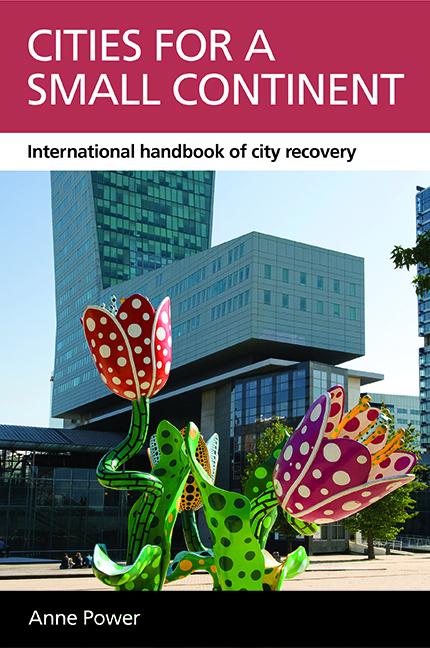Book contents
- Frontmatter
- Contents
- List of tables and figures
- Abbreviations and acronyms
- Acknowledgements
- Copyright material
- Foreword
- one Lessons from cities in a crowded continent Tale of a city – Bilbao
- two Divided and united Europe Tale of a city – Belfast
- three Grit and vision Tale of a city – Sheffield
- four Struggle and strive Tale of a city – Lille
- five Threats and opportunities Tale of a city – St Étienne
- six Over-scale and under-scale Tale of a city – Torino
- seven The power of social innovation Tale of a city – Leipzig
- eight Shoots of growth in older industrial cities in the US Tale of a city – Detroit
- nine Finding new ways out of the woods
- Endnotes
- References
- Afterword
- La Fabrique de la Cité
- Index
three - Grit and vision Tale of a city – Sheffield
Published online by Cambridge University Press: 01 September 2022
- Frontmatter
- Contents
- List of tables and figures
- Abbreviations and acronyms
- Acknowledgements
- Copyright material
- Foreword
- one Lessons from cities in a crowded continent Tale of a city – Bilbao
- two Divided and united Europe Tale of a city – Belfast
- three Grit and vision Tale of a city – Sheffield
- four Struggle and strive Tale of a city – Lille
- five Threats and opportunities Tale of a city – St Étienne
- six Over-scale and under-scale Tale of a city – Torino
- seven The power of social innovation Tale of a city – Leipzig
- eight Shoots of growth in older industrial cities in the US Tale of a city – Detroit
- nine Finding new ways out of the woods
- Endnotes
- References
- Afterword
- La Fabrique de la Cité
- Index
Summary
The earth, our home, is beginning to look more and more like an immense pile of filth… We need only take a frank look at the facts to see that our common home is falling into serious disrepair. Hope would have us recognise there is always a way out, that we can always redirect our steps, that we can always do something to solve our own problems. Pope Francis, Laudato Si’
Box 3.1: Sheffield – a story
A visitor arriving at Sheffield by train stands inside the lovingly restored, sand stone Victorian station, with its ten ornate wide arches spanning the frontage. Outside, a new square has been carved out of a former carpark and turning point, cut off from the busy dual carriageway through the city centre by a modern high steel wall sculpture-cum-barrier. The functional sculpture acts as a noise shield against the roar of traffic. It is also a gentle waterfall as a film of sparkling water flows down the shiny, undulating steel surface, linking the new space to the city’s steel making past. This popular new square hosts special events, exhibitions and public gatherings, displacing cars with people.
Above the station, straddling the steep hillside, loom the gleaming high rise concrete blocks of the Park Hill estate, a listed monument to the brave 1960s vision of replacing old slums with new hope, now being refitted and reoccupied by old and new residents. Between the station and the estate sits the Olympicsize swimming pool, built in the heady 1980s when Sheffield bravely resisted the Thatcher government's cuts to its budget and hosted the World Student Games. These different monuments unite Sheffield's past and future.
Sheffield's vision is best captured in the giant metallic sculpture inside the Winter Garden made entirely of Sheffield cutlery. Sheffield's fame had already spread by the 1740s as the world's leading knife maker when it invented crucible steel and silver plating. Today, cutlery is replaced by blade making and other ultra-modern manufacture. Its engineering prowess, its super-strong steel, its blades, fuel a new economy. Advanced manufacturing is a race Sheffield wants to win against huge odds, following the boom and bust of the post-war years.
- Type
- Chapter
- Information
- Cities for a Small ContinentInternational Handbook of City Recovery, pp. 55 - 92Publisher: Bristol University PressPrint publication year: 2016



